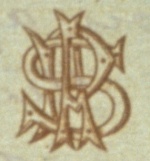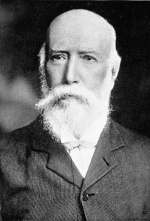Alfred Percy Sinnett: Difference between revisions
Pablo Sender (talk | contribs) |
Pablo Sender (talk | contribs) |
||
| Line 27: | Line 27: | ||
Soon after Sinnett's meeting with the [[Founders]] he established a correspondence with the [[Mahatmas]]. Through this correspondence and his involvement with [[Theosophy]] his attitude about the natives and the Indian affairs began to change, becoming more supportive. | Soon after Sinnett's meeting with the [[Founders]] he established a correspondence with the [[Mahatmas]]. Through this correspondence and his involvement with [[Theosophy]] his attitude about the natives and the Indian affairs began to change, becoming more supportive. | ||
In 1882, [[Clive Rattigan]] purchased ''The Pioneer'' from Allen and the new proprietors communicated to Mr. Sinnett that at the end of his engagement, in November | In 1882, [[Clive Rattigan]] purchased ''The Pioneer'' from Allen and the new proprietors communicated to Mr. Sinnett that at the end of his engagement, in November that year, the newspaper would no longer need his services. Sinnett wrote of Rattigan: | ||
<blockquote> | <blockquote> | ||
Revision as of 21:25, 12 July 2012
Alfred Percy Sinnett (18 January 1840, London - 26 June 1921) was an English author, journalist, and Theosophist, who played an important part in growth of the Theosophical Society during its first generation.
Bio-data
Alfred's father died while he was only five years old. His childhood was one of deprivations; his widowed mother Jane having to sustain three boys and three girls by writing newspaper articles and translations, with the help of his older sister Sophia, age 22, who was a teacher. Young Sinnett did poorly at school and left it without finishing his studies. He eventually obtained a position as assistant and sub-editor of The Globe, an evening newspaper.
Sinnett married his wife Patience Edensor on April 6, 1870, probably in the London area. By that time he had become and editorial writer for The Evening Standard. He is listed in the 1871 England Census at age 31, as a Journalist, born in Middlesex. His wife Patience is listed as 27, and her mother Clarissa Edenson, a "Landowner", is living with them.
In 1872 Mr. George Allen, the proprietor of the Anglo-Indian newspaper The Pioneer offered him the editorship. He resigned his previous position and left for India, arriving at Allahabad toward the end of the year. During these first years in India he had a good income, a good social life, and professional recognition.
In May 1877 Mrs. Sinnett gave birth to a son, Denny, who died from tuberculosis in 1908.
In 1879 he meets the founders of the Theosophical Society and begins a life-long association with them and the organization. By the end of 1882, and mainly because of his involvement with Theosophy, Sinnett was dismissed as the Editor of The Pioneer.
In 1883 he returns to England and joins the London Lodge.
In 1889, Sinnett asked Charles Webster Leadbeater to come back to England to tutor his son Percy and George Arundale. Leadbeater agreed and brought with him one of his pupils Curuppumullage Jinarājadāsa. Using "astral clairvoyance" Leadbeater assisted William Scott-Elliot to write his book The Story of Atlantis, for which Sinnett wrote the preface.
Sinnett was later President of the London Lodge of the Theosophical Society.
Work at The Pioneer
In 1872, Sinnett became editor of The Pioneer, owned by Sir George William Allen.[1] In the eleven years of his editorship, the little paper grew into the leading Anglo-Indian daily newspaper of the day.[2]
Soon after Sinnett's meeting with the Founders he established a correspondence with the Mahatmas. Through this correspondence and his involvement with Theosophy his attitude about the natives and the Indian affairs began to change, becoming more supportive.
In 1882, Clive Rattigan purchased The Pioneer from Allen and the new proprietors communicated to Mr. Sinnett that at the end of his engagement, in November that year, the newspaper would no longer need his services. Sinnett wrote of Rattigan:
He had been from the first intensely unsympathetic with my interest in the occult development ..., but for my connection with Theosophy it would have been unlikely that my connection with the Pioneer would have been disturbed at this period. There was some friction between myself and the new proprietors, but my success as writer had become fairly conspicuous and the friction such as it was would not have been enough to break the tie. But again both my wife and I had grown tired of the Indian life and wished to be back in England. It seemed just possible that the savings of our time in India, plus journalistic work at home, would enable us to live there in moderate comfort, so that we contemplated my resignation of the Pioneer editorship as a step we might be inclined to take. The parting therefore was neither strained nor unfriendly, and for many years after my return to England I continued to write articles of various kinds for the paper in India.[3]
Evidence that the relationship with the paper remained cordial is shown that around 1891, he was able to help Charles Webster Leadbeater obtain employment in the London office of The Pioneer.[4]
The Mahatma Letters

In 1875, during a visit to London, he became interested in Spiritualism. When Madame Blavatsky and Colonel Olcott arrived in Bombay early in 1879, assuming they were Spiritualists, wrote to the Founders inviting them to visit him to Allahabad. He relates in his book, The Occult World that:
...on the first occasion of my making Madame Blavatsky's acquaintance she became a guest at my home at Allahabad and remained there for six weeks...[5]
In 1880 Helena Blavatsky and Henry Steel Olcott visited the Sinnetts at their summer-home in Simla. In 1880 Helena Blavatsky and Henry Steel Olcott visited the Sinnetts at their summer-home in Simla. During this time, many wonderful phenomena took place that Mr. Sinnett described in his book The Occult World. Although the phenomena were performed in front of witnesses and in a careful way, Sinnett wanted to design one "really complete in their details and leave no opening for the suggestion even of imposture."[6] It was then that the famous correspondence with the Mahatmas began. In Sinnett's words:
One day, therefore, I asked Madame Blavatsky whether if I wrote a letter to one of the Brothers explaining my views, she could get it delivered for me. I hardly thought this was probable, as I knew how very unapproachable the Brothers generally are; but as she said that at any rate she would try, I wrote a letter, addressing it " to the Unknown Brother," and gave it to her to see if any result would ensue. It was a happy inspiration that induced me to do this, for out of that small beginning has arisen the most interesting correspondence in which I have ever been privileged to engage.[7]
The "Unknown Brother" that answered was known as Mahatma Koot Hoomi, and from this grew a correspondence that took place from 1880 to 1885, and was published under the title The Mahatma Letters to A. P. Sinnett.
The Phoenix
After having being dismissed from The Pioneer, in 1883, an effort was made by the Master K. H. to enlist the journalistic ability of Sinnett to organize a newspaper called the Phoenix, supported by Indian capital. This newspaper sought to help in raising the social and economic condition of the Indian masses, and arise their sense of self-respect and their standing in the eyes of the world.
Sinnett left for England hoping to return to India for this project, but after considerable efforts to raise the funds needed the enterprise had to be abandoned for lack of support from the Indians.
Writings
By 1901, Sinnett is listed as an author. His son Percy is also listed as an author and born in India.[8]
- The Early Days of Theosphy in Europe. Theosophical Publishing House Ltd, London, 1922. Available online at Canadian Theosophical Association. Published posthumously, this gives an account of how the Sinnetts came to invite HPB to Simla; how APS left The Pioneer; use of the term Brotherhood; Anna Bonus Kingsford; HPB's time in Europe; the Gebhard family; and many other aspects of early TS history.
Notes
- ↑ "Sir George William Allen KCIE," [1]
- ↑ Combined Chronology of The Mahatma Letters - Preface
- ↑ Alfred Percy Sinnett, Early Days of Theosophy in Europe. (Theosophical Publishing House Ltd, London, 1922),38-39. Available online at Canadian Theosophical Association.
- ↑ Alfred Percy Sinnett, Early Days of Theosophy in Europe. (Theosophical Publishing House Ltd, London, 1922),110-111. Available online at Canadian Theosophical Association.
- ↑ Alfred Peercy Sinnett,The Occult World, 42. Available at WikiSource.
- ↑ Alfred Percy Sinnett, The Occult World (London: Theosophical Publishing House, 1969), 81.
- ↑ Alfred Percy Sinnett, The Occult World (London: Theosophical Publishing House, 1969), 82.
- ↑ 1901 England Census

